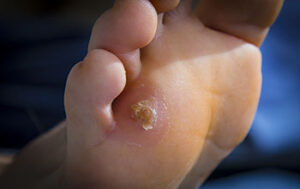 Seed corn on foot forms as a way for the skin to protect itself from repetitive friction, irritation, and rubbing. Seed corn is a collection of small corns that are stiff, dry, and bumpy, appearing like a seed. They are circular, hard, and have well-defined spots on the foot skin. Corn on bottom of foot can be formed on the feet including the ball of the foot and the bottom of the heel. Most of the time foot corn develops due to poorly fitting shoes but wearing proper-fitting shoes would solve the problem. Foot callus and seed corns are not problematic but they can be painful during activities such as running or walking.
Seed corn on foot forms as a way for the skin to protect itself from repetitive friction, irritation, and rubbing. Seed corn is a collection of small corns that are stiff, dry, and bumpy, appearing like a seed. They are circular, hard, and have well-defined spots on the foot skin. Corn on bottom of foot can be formed on the feet including the ball of the foot and the bottom of the heel. Most of the time foot corn develops due to poorly fitting shoes but wearing proper-fitting shoes would solve the problem. Foot callus and seed corns are not problematic but they can be painful during activities such as running or walking.
Shoe Corn Formation:
The majority of seed corn formations are due to friction injuries from shoes such as high heels. Corns develop as a response to constant rubbing. Loose shoes cause excessive rubbing in some areas of the foot, prompting the skin to grow thick. Proper fitting shoes will keep these problems away.
Socks Seed Corn Formation:
Socks are the best in the prevention of seed corn formation by avoiding excess friction from the shoes. If the socks are too tight or loose, they can contribute to the formation of seed corns.
Overuse and Repetitive stress:
Repetitive stress or friction to the skin can cause foot corn. It also includes repeated running or walking up and down hills or doing it for long distances. Surprisingly, even working for long on hard surfaces, including standing, can lead to corns. In cases of uneven gait, the feet bear weight differently with the potential of causing seed corns. Overuse and repetition are not the limited ways for corn formations because there are different weight-bearing and standing activities that can cause them.
Acquired and Congenital Deformities:
Any foot condition that alters the shape of the foot, poses the risk of corn formation to the foot. A bone spur is a condition that forms at the end of the bone and can cause excessive rubbing that can lead to corns. Bunions also hasten corn formation. Forms of fixed, unnatural joints contracture and hammertoes often can cause the formation of seed corns.
Corn on foot treatment
Home care treatment can cause the seed corns to disappear but then the amount of time varies between individuals. If the seed corns are persistent after treating at home consult a doctor to avoid infections and complications.
- Soak your feet.
Soaking the feet in warm soapy water softens the seed corns. Soaking for 5 to 10 minutes will cause easy reduction of the corns.
- Reduce the thickened skin.
Take time to thin the skin thickened by seed corns using one of these methods:
- Filing – Use an emery board or a pumice stone to file away layers of thick skin. Be gentle while filing also avoid filing away too much skin. If you have underlying conditions that affect the feet, have a professional do this for you.
- Over-the-counter medications – The medications contain salicylic acid and are available as pads or liquids. However, if you have other underlying conditions that affect blood flow or diabetes, avoid using this method.
- Moisturize
Use a moisturizer on the soles of the feet to hydrate and soften your skin.
- Footwear
While treating seed corns, wear fitting and comfortable footwear including shoes and socks.
Make an appointment with a foot doctor if the seed corns are very painful, appear infected, inflamed, or significantly interfere with daily activities. Please feel free to contact our Houston, TX office if you have any questions about foot corns. For all of your foot and ankle needs, we use the most up-to-date diagnostic and treatment technologies. Our foot specialist doctor can provide the care you need to keep you pain-free and on your feet.
Comments
[…] other foot lesions such as plantar warts or calluses. Hard corn, seed corn, and soft corn are all types of corns on feet. Thickened skin develops in the area of the foot pressure or friction to form […]